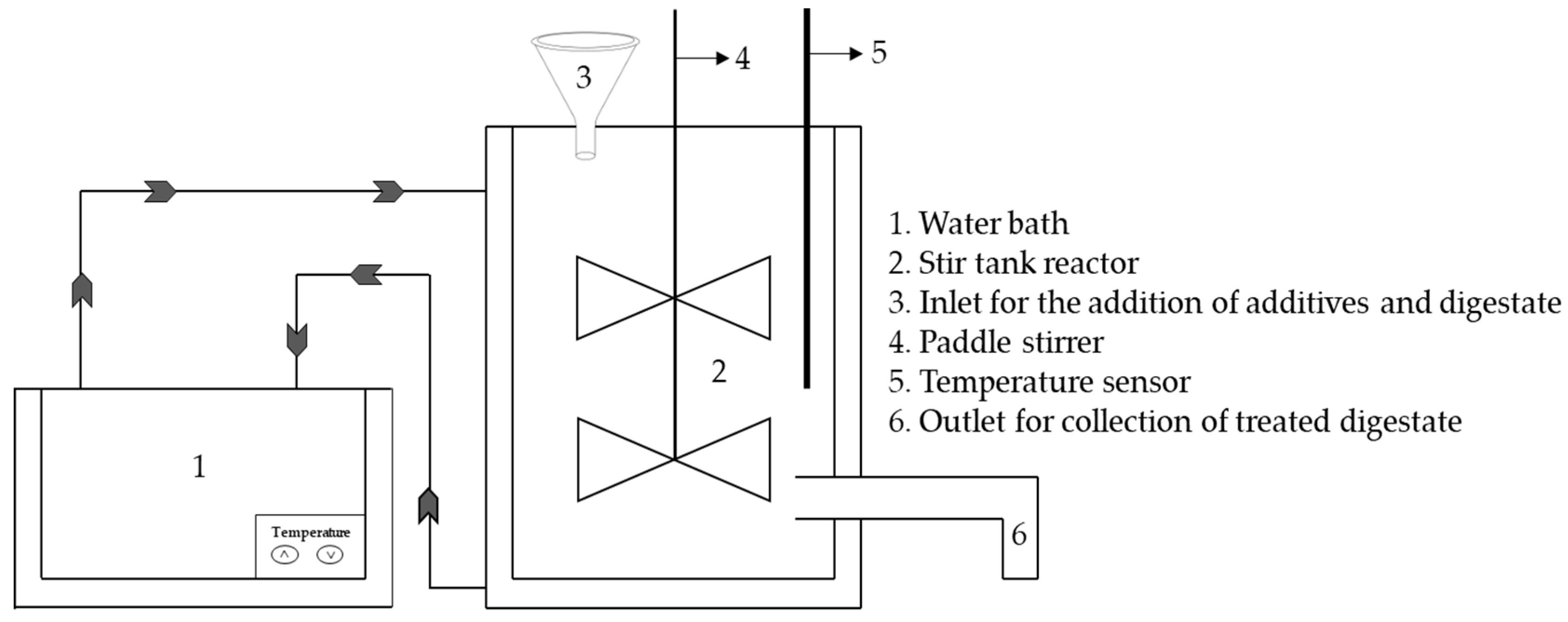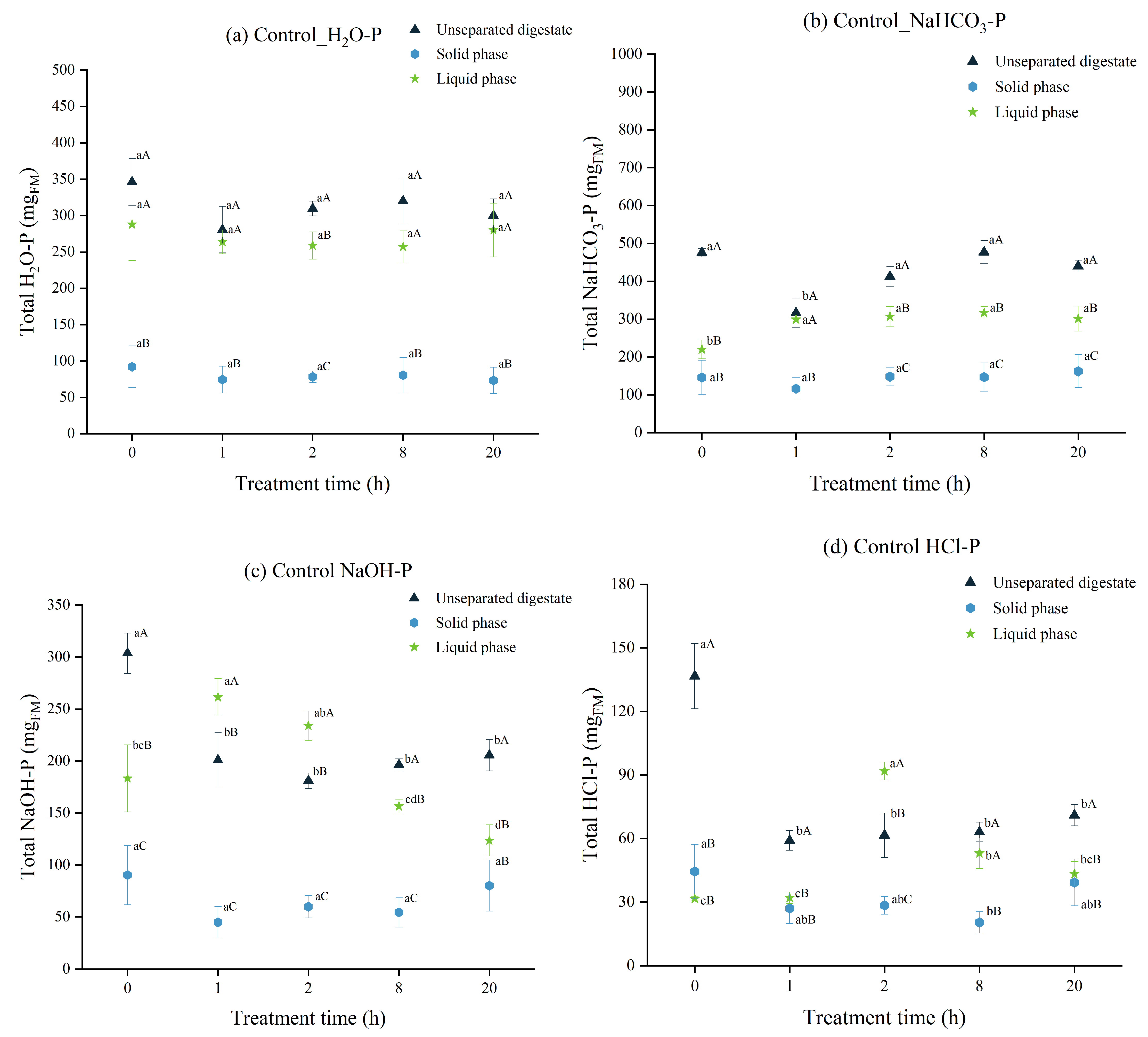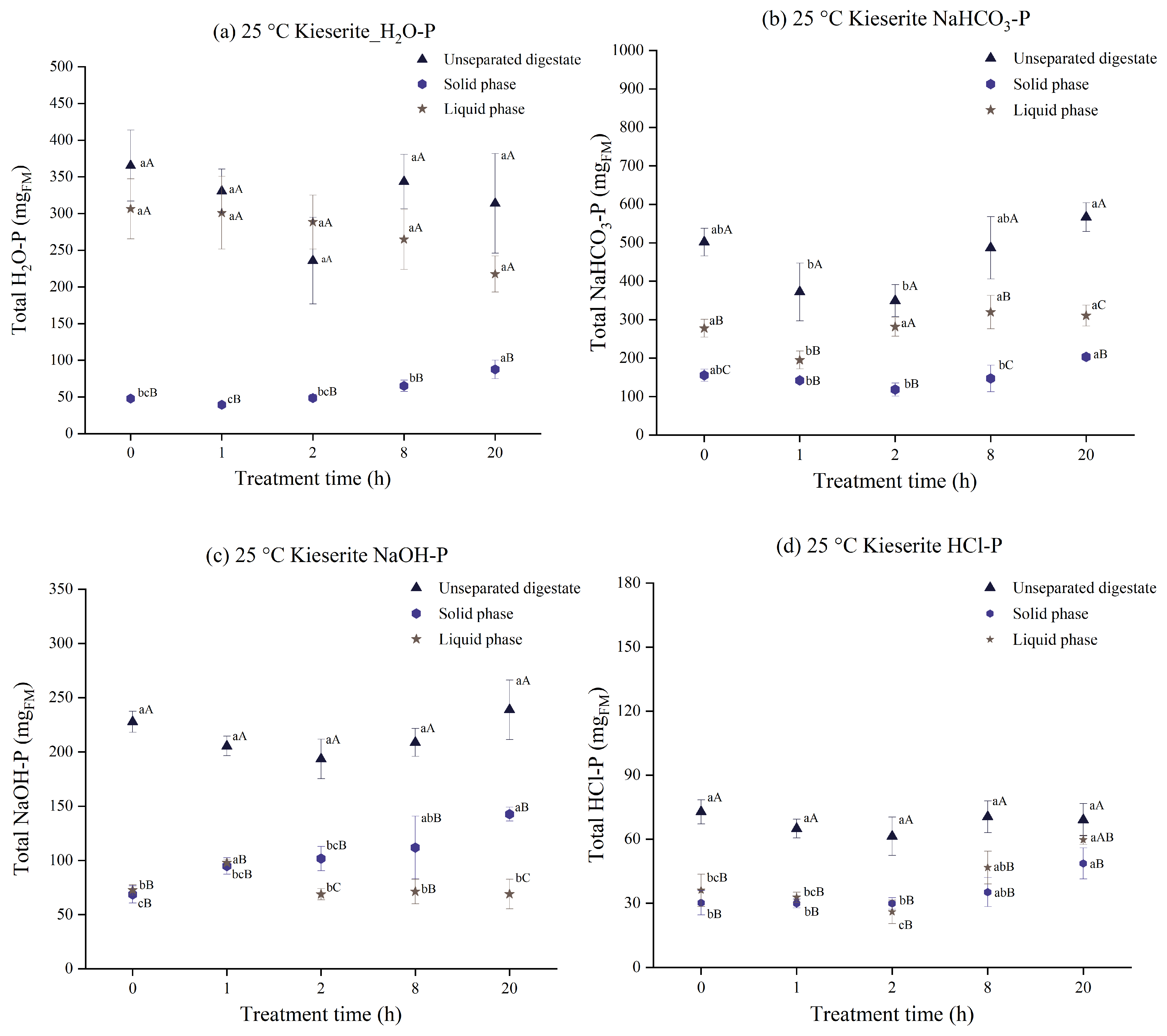Effect of Reactive and Non-Reactive Additive Treatment on the Recovery of Phosphorus from Biogas Digestate
Abstract
:1. Introduction
2. Materials and Methods
2.1. Substrate
2.2. Additives
2.2.1. Reactor
2.2.2. Mechanical Solid–Liquid Separation
2.3. Experimental Setup
2.4. Analytical Methods
2.5. Sequential Chemical Extraction
2.6. Statistical Analysis
3. Results and Discussion
3.1. Total Phosphorus Recovery
3.2. Effect of Additve Treatment on P Fractionation and Distribution
3.2.1. Comparison of P Extractant Fractions after Additive Treatment
3.2.2. Effect of Treatment Time on the Distribution of P Extractant Fractions
- a.
- Control
- b.
- Kieserite treatment at 25 °C
- c.
- Kieserite treatment at 50 °C
- d.
- Biochar treatment
- e.
- Straw flour treatment
- f.
- Summary of findings from the sequential extraction process
4. Conclusions
Supplementary Materials
Author Contributions
Funding
Data Availability Statement
Acknowledgments
Conflicts of Interest
References
- Steffen, W.; Richardson, K.; Rockström, J.; Cornell, S.E.; Fetzer, I.; Bennett, E.M.; Biggs, R.; Carpenter, S.R.; De Vries, W.; De Wit, C.A.; et al. Planetary boundaries: Guiding human development on a changing planet. Science 2015, 347, 1259855. [Google Scholar] [CrossRef] [Green Version]
- USGS 2022 Mineral Commodity Summaries 2022—Phosphate. Available online: https://pubs.usgs.gov/periodicals/mcs2022/mcs2022-phosphate.pdf (accessed on 18 April 2023).
- Ren, Y.; Yu, M.; Wu, C.; Wang, Q.; Gao, M.; Huang, Q.; Liu, Y. A comprehensive review on food waste anaerobic digestion: Research updates and tendencies. Bioresour. Technol. 2018, 247, 1069–1076. [Google Scholar] [CrossRef] [PubMed]
- Chen, L.; Wei, J.; Wang, W.; Wang, C. Combination of microalgae cultivation with membrane processes for the treatment of municipal wastewater. Water Sci. Technol. 2013, 68, 2374–2381. [Google Scholar] [CrossRef]
- Morozova, I.; Lemmer, A. Nutrient Recovery from Digestate of Agricultural Biogas Plants: A Comparative Study of Innovative Biocoal-Based Additives in Laboratory and Full-Scale Experiments. Molecules 2022, 27, 5289. [Google Scholar] [CrossRef] [PubMed]
- Li, B.; Dinkler, K.; Zhao, N.; Ran, X.; Sobhi, M.; Dong, R.; Müller, J.; Xiong, W.; Huang, G.; Guo, J.; et al. Response of phosphorus speciation to organic loading rates and temperatures during anaerobic co-digestion of animal manures and wheat straw. Sci. Total. Environ. 2022, 838 Pt 1, 155921. [Google Scholar] [CrossRef]
- Ma, H.; Guo, Y.; Qin, Y.; Li, Y.-Y. Nutrient recovery technologies integrated with energy recovery by waste biomass anaerobic digestion. Bioresour. Technol. 2018, 269, 520–531. [Google Scholar] [CrossRef]
- Mai, D.T.; Kunacheva, C.; Stuckey, D.C. A review of posttreatment technologies for anaerobic effluents for discharge and recycling of wastewater. Crit. Rev. Environ. Sci. Technol. 2018, 48, 167–209. [Google Scholar] [CrossRef]
- Drosg, B.; Fuchs, W.; Al Seadi, T.; Madsen, M.; Linke, B. Nutrient Recovery by Biogas Digestate Processing; IEA Bioenergy: Dublin, Ireland, 2015. [Google Scholar]
- Bauer, A.; Mayr, H.; Hopfner-Sixt, K.; Amon, T. Detailed monitoring of two biogas plants and mechanical solid–liquid separation of fermentation residues. J. Biotechnol. 2009, 142, 56–63. [Google Scholar] [CrossRef]
- Severin, M.; Fuß, R.; Well, R.; Hähndel, R.; Weghe, H.V.D. Greenhouse gas emissions after application of digestate: Short-term effects of nitrification inhibitor and application technique effects. Arch. Agron. Soil Sci. 2016, 62, 1007–1020. [Google Scholar] [CrossRef]
- Möller, K.; Müller, T. Effects of anaerobic digestion on digestate nutrient availability and crop growth: A review. Eng. Life Sci. 2012, 12, 242–257. [Google Scholar] [CrossRef]
- Nkoa, R. Agricultural benefits and environmental risks of soil fertilization with anaerobic digestates: A review. Agron. Sustain. Dev. 2014, 34, 473–492. [Google Scholar] [CrossRef] [Green Version]
- Rehl, T.; Müller, J. Life cycle assessment of biogas digestate processing technologies. Resour. Conserv. Recycl. 2011, 56, 92–104. [Google Scholar] [CrossRef]
- Shi, L.; Simplicio, W.S.; Wu, G.; Hu, Z.; Hu, H.; Zhan, X. Nutrient Recovery from Digestate of Anaerobic Digestion of Livestock Manure: A Review. Curr. Pollut. Rep. 2018, 4, 74–83. [Google Scholar] [CrossRef]
- Digestate as Fertilizer. Available online: https://www.biogas.org/edcom/webfvb.nsf/id/BJHCPA-DE-Digestate-as-Fertilizer (accessed on 15 March 2023).
- KTBL. Umweltgerechte, Innovative Verfahren zur Abtrennung von Nährstoffen aus Gülle und Gärrückständen—Technologischer Stand, Perspektiven und Entwicklungsmöglichkeiten; Deutschen Bundesstiftung Umwelt, erstellt durch das Kuratorium für Technik und Bauwesen in der Landwirtschaft (KTBL): Darmstadt, Germany; Institut für Technologie und Biosystemtechnik der Bundesforschungsanstalt für Landwirtschaft (FAL): Braunschweig, Germany, 2008. [Google Scholar]
- Lyons, G.A.; Cathcart, A.; Frost, J.P.; Wills, M.; Johnston, C.; Ramsey, R.; Smyth, B. Review of Two Mechanical Separation Technologies for the Sustainable Management of Agricultural Phosphorus in Nutrient-Vulnerable Zones. Agronomy 2021, 11, 836. [Google Scholar] [CrossRef]
- Finch, H.; Samue, l.A.M.; Lane, G. Fertilisers and manures. In Lockhart & Wiseman’s Crop Husbandry Including Grassland; Elsevier: Amsterdam, The Netherlands, 2014; pp. 63–91. [Google Scholar]
- ESTA® Kieserit Gran.—K+S Aktiengesellschaft. Available online: https://www.kpluss.com/de-de/geschaeftsfelder-produkte/landwirtschaft/produkte/de-esta-kieserit-gran/ (accessed on 15 March 2023).
- Laird, D.A.; Brown, R.C.; Amonette, J.E.; Lehmann, J. Review of the pyrolysis platform for coproducing bio-oil and biochar. Biofuels Bioprod. Biorefining 2009, 3, 547–562. [Google Scholar] [CrossRef]
- Wolff, G.A.; Billett, D.S.M.; Bett, B.J.; Holtvoeth, J.; FitzGeorge-Balfour, T.; Fisher, E.H.; Cross, I.; Shannon, R.; Salter, I.; Boorman, B.; et al. The Effects of Natural Iron Fertilisation on Deep-Sea Ecology: The Crozet Plateau, Southern Indian Ocean. PLoS ONE 2011, 6, e20697. [Google Scholar] [CrossRef] [Green Version]
- Novotny, E.H.; de Freitas Maia, C.M.B.; de Melo Carvalho, M.T.; Madari, B.E. Biochar: Pyrogenic carbon for agricultural use—A critical review. Rev. Bras. Ciência Solo 2015, 39, 321–344. [Google Scholar] [CrossRef] [Green Version]
- Ahmad, M.; Rajapaksha, A.U.; Lim, J.E.; Zhang, M.; Bolan, N.; Mohan, D.; Vithanage, M.; Lee, S.S.; Ok, Y.S. Biochar as a sorbent for contaminant management in soil and water: A review. Chemosphere 2014, 99, 19–33. [Google Scholar] [CrossRef]
- Alling, V.; Hale, S.E.; Martinsen, V.; Mulder, J.; Smebye, A.; Breedveld, G.D.; Cornelissen, G. The role of biochar in retaining nutrients in amended tropical soils. J. Plant Nutr. Soil Sci. 2014, 177, 671–680. [Google Scholar] [CrossRef]
- Joseph, S.D.; Camps-Arbestain, M.; Lin, Y.; Munroe, P.; Chia, C.H.; Hook, J.; van Zwieten, L.; Kimber, S.; Cowie, A.; Singh, B.P.; et al. An investigation into the reactions of biochar in soil. Soil Res. 2010, 48, 501–515. [Google Scholar] [CrossRef]
- Chen, L.; Sun, S.; Yao, B.; Peng, Y.; Gao, C.; Qin, T.; Zhou, Y.; Sun, C.; Quan, W. Effects of straw return and straw biochar on soil properties and crop growth: A review. Front. Plant Sci. 2022, 13, 986763. [Google Scholar] [CrossRef] [PubMed]
- Tuyttens, F.A.M. The importance of straw for pig and cattle welfare: A review. Appl. Anim. Behav. Sci. 2005, 92, 261–282. [Google Scholar] [CrossRef]
- Schoumans, O.; Ehlert, P.; Regelink, I.; Nelemans, J.; Noij, I.; van Tintelen, W.; Rulkens, W.; Food, W.A. Chemical Phosphorus Recovery from Animal Manure and Digestate: Laboratory and Pilot Experiments; Wageningen Environmental Research: Wageningen, The Netherlands, 2017. [Google Scholar] [CrossRef] [Green Version]
- Ye, Y.; Ngo, H.H.; Guo, W.; Liu, Y.; Li, J.; Liu, Y.; Zhang, X.; Jia, H. Insight into chemical phosphate recovery from municipal wastewater. Sci. Total. Environ. 2017, 576, 159–171. [Google Scholar] [CrossRef]
- Campos, J.L.; Crutchik, D.; Franchi, Ó.; Pavissich, J.P.; Belmonte, M.; Pedrouso, A.; Mosquera-Corral, A.; Val del Río, Á. Nitrogen and Phosphorus Recovery from Anaerobically Pretreated Agro-Food Wastes: A Review. Front. Sustain. Food Syst. 2019, 2, 91. [Google Scholar] [CrossRef] [Green Version]
- Lehmann, J. Bio-energy in the black. Front. Ecol. Environ. 2007, 5, 381–387. [Google Scholar] [CrossRef] [Green Version]
- Alberto, D.R.; Tyler, A.C.; Trabold, T.A. Phosphate adsorption using biochar derived from solid digestate. Bioresour. Technol. Rep. 2021, 16, 100864. [Google Scholar] [CrossRef]
- Kizito, S.; Wu, S.; Kirui, W.K.; Lei, M.; Lu, Q.; Bah, H.; Dong, R. Evaluation of slow pyrolyzed wood and rice husks biochar for adsorption of ammonium nitrogen from piggery manure anaerobic digestate slurry. Sci. Total. Environ. 2015, 505, 102–112. [Google Scholar] [CrossRef]
- Bhuiyan, M.I.H.; Mavinic, D.S.; Beckie, R.D. A solubility and thermodynamic study of struvite. Environ. Technol. 2007, 28, 1015–1026. [Google Scholar] [CrossRef]
- Krumgalz, B.S. Temperature Dependence of Mineral Solubility in Water. Part 3. Alkaline and Alkaline Earth Sulfates. J. Phys. Chem. Ref. Data 2018, 47, 23101. [Google Scholar] [CrossRef]
- Urbanowska, A.; Polowczyk, I.; Kabsch-Korbutowicz, M. Struvite precipitation from the liquid fraction of the digestate of a municipal waste biogas plant. Environ. Prot. Eng. 2021, 47, 85–99. [Google Scholar] [CrossRef]
- González-Morales, C.; Fernández, B.; Molina, F.J.; Naranjo-Fernández, D.; Matamoros-Veloza, A.; Camargo-Valero, M.A. Influence of pH and Temperature on Struvite Purity and Recovery from Anaerobic Digestate. Sustainability 2021, 13, 10730. [Google Scholar] [CrossRef]
- Hedley, M.J.; Stewart, J.W.B.; Chauhan, B.S. Changes in Inorganic and Organic Soil Phosphorus Fractions Induced by Cultivation Practices and by Laboratory Incubations. Soil Sci. Soc. Am. J. 1982, 46, 970–976. [Google Scholar] [CrossRef]
- Dinkler, K.; Li, B.; Guo, J.; Hülsemann, B.; Becker, G.C.; Müller, J.; Oechsner, H. Adapted Hedley fractionation for the analysis of inorganic phosphate in biogas digestate. Bioresour. Technol. 2021, 331, 125038. [Google Scholar] [CrossRef]
- Bachmann, S.; Wentzel, S.; Eichler-Löbermann, B. Codigested dairy slurry as a phosphorus and nitrogen source for Zea mays L. and Amaranthus cruentus L. J. Plant. Nutr. Soil Sci. 2011, 174, 908–915. [Google Scholar] [CrossRef]
- Dou, Z.; Toth, J.D.; Galligan, D.T.; Ramberg, C.F.; Ferguson, J.D. Laboratory Procedures for Characterizing Manure Phosphorus. J. Environ. Qual. 2000, 29, 508–514. [Google Scholar] [CrossRef]
- Baird, R.B.; Eaton, A.D. (Eds.) . Standard Methods for Examination of Water and Wastewater, 23rd ed.; American Public Health Association: Washington, DC, USA, 2017. [Google Scholar]
- Levy, E.T.; Schlesinger, W.H. A comparison of fractionation methods for forms of phosphorus in soils. Biogeochemistry 1999, 47, 25–38. [Google Scholar] [CrossRef]
- Li, B.; Dinkler, K.; Zhao, N.; Sobhi, M.; Merkle, W.; Liu, S.; Dong, R.; Oechsner, H.; Guo, J. Influence of anaerobic digestion on the labile phosphorus in pig, chicken, and dairy manure. Sci. Total. Environ. 2020, 737, 140234. [Google Scholar] [CrossRef]
- Hsu, J.C.; Peruggia, M. Graphical Representations of Tukey’s Multiple Comparison Method. J. Comput. Graph. Stat. 1994, 3, 143. [Google Scholar] [CrossRef]
- Piepho, H.P. Letters in mean comparisons: What they do and don’t mean. Agron. J. 2018, 110, 431–434. [Google Scholar] [CrossRef] [Green Version]










| TS | VS | N | P | K | |
|---|---|---|---|---|---|
| (%) | (%) | (g kgTS−1) | (g kgTS−1) | (g kgTS−1) | |
| Digestate | 5.43 ± 0.14 | 3.64 ± 0.1 | 70.79 ± 1.04 | 0.60 ± 0.06 | 5.08 ± 1.08 |
| Additive | Temperature, °C | Treatment Time, h | |||||
|---|---|---|---|---|---|---|---|
| 0 | 1 | 2 | 8 | 20 | |||
| KIS 25 | Kieserite | 25 | ✓ | ✓ | ✓ | ✓ | ✓ |
| KIS 50 | Kieserite | 50 | ✓ | ✓ | ✓ | ✓ | ✓ |
| BIC 25 | Biochar (1–2 mm) | 25 | ✓ | ✓ | ✓ | ✓ | ✓ |
| STF 25 | Straw flour | 25 | ✓ | ✓ | ✓ | ✓ | ✓ |
| Control | None | 25 | ✓ | ✓ | ✓ | ✓ | ✓ |
Disclaimer/Publisher’s Note: The statements, opinions and data contained in all publications are solely those of the individual author(s) and contributor(s) and not of MDPI and/or the editor(s). MDPI and/or the editor(s) disclaim responsibility for any injury to people or property resulting from any ideas, methods, instructions or products referred to in the content. |
© 2023 by the authors. Licensee MDPI, Basel, Switzerland. This article is an open access article distributed under the terms and conditions of the Creative Commons Attribution (CC BY) license (https://creativecommons.org/licenses/by/4.0/).
Share and Cite
Uppuluri, N.S.T.; Dinkler, K.; Ran, X.; Guo, J.; Müller, J.; Oechsner, H. Effect of Reactive and Non-Reactive Additive Treatment on the Recovery of Phosphorus from Biogas Digestate. Energies 2023, 16, 5464. https://doi.org/10.3390/en16145464
Uppuluri NST, Dinkler K, Ran X, Guo J, Müller J, Oechsner H. Effect of Reactive and Non-Reactive Additive Treatment on the Recovery of Phosphorus from Biogas Digestate. Energies. 2023; 16(14):5464. https://doi.org/10.3390/en16145464
Chicago/Turabian StyleUppuluri, Naga Sai Tejaswi, Konstantin Dinkler, Xueling Ran, Jianbin Guo, Joachim Müller, and Hans Oechsner. 2023. "Effect of Reactive and Non-Reactive Additive Treatment on the Recovery of Phosphorus from Biogas Digestate" Energies 16, no. 14: 5464. https://doi.org/10.3390/en16145464






